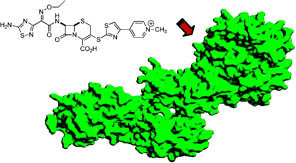
The Journal of the American Chemical Society will publish research led by Prof. Shahriar Mobashery on two drugs that are undergoing clinical trials to fight the highly resistant superbug called methicillin-resistantStaphylococcus aureus (MRSA). The broad-spectrum antibiotics from Cerexa, Inc. – ceftaroline (CPT), a cephalosporin, and ME1036 (ME), a carbapenem – show excellent efficacy in fighting the bacterium that has become a global health threat.
The paper is entitled “Co-opting the Cell Wall in Fighting Methicillin-Resistant Staphylococcus aureus: Potent Inhibition of PBP 2a by Two Anti-MRSA β-Lactam Antibiotics.” Contributing authors include Adriel Villegas-Estrada, Mijoon Lee, Dusan Hesek and Sergei B. Vakulenko.
The resistant S. aureus has a novel protein called penicillin-binding protein 2a (PBP 2a) that is not susceptible to inhibition by all clinical drugs. “In contrast to the commercially available β-lactam antibiotics, CPT and ME are exquisite inhibitors of PBP 2a of MRSA,” the report says. “These antibiotics bind with high affinity to PBP 2a and inhibit its activity, thus disrupting cell wall biosynthesis.”
The researchers say that CPT and ME work by a dual mechanism of action. They are highly potent in their interactions with the drug target, PBP 2a. But the researchers provide additional evidence that these antibiotics co-opt the interactions of the cell wall on the surface of PBP 2a to inhibit the enzyme even more potently. The mode of the inhibition was such that the complex of the drug with the protein did not reverse itself, a factor that underlies the potency of the drugs. CPT and ME were “exquisitely active” against MRSA strains that show resistance to other drugs used to treat infections,.
The National Institutes of Health and Cerexa, Inc., a wholly owned subsidiary of Forest Laboratories, Inc., supported the research. Prof. Mobashery holds the Navari Family Chair in Life Sciences in the Department of Chemistry and Biochemistry at the University of Notre Dame.
The article was published in the online version of the Journal of the American Chemical Society on June 26, 2008 and will be published in the print version of the journal shortly.